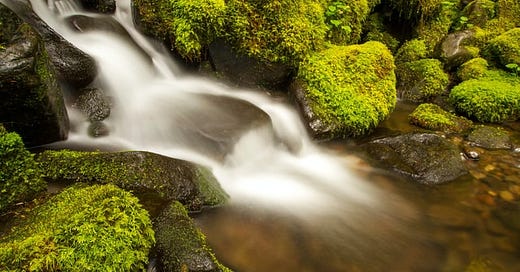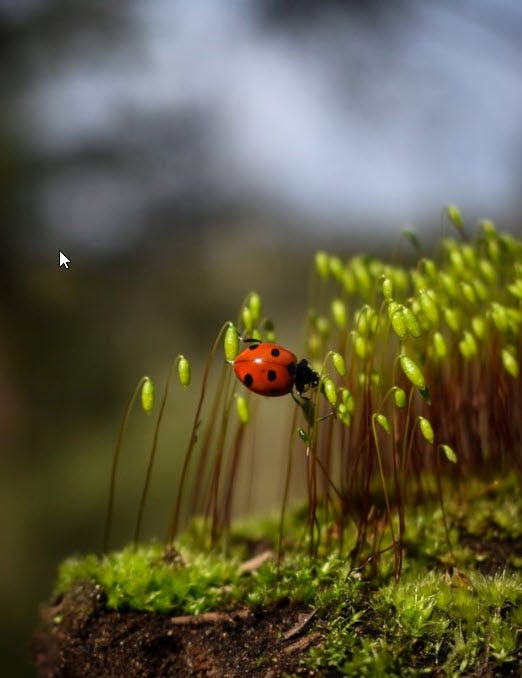Welcome! You’re at Mother E, telling the stories about our connections with other species in a changing world.
If you missed the last edition on biomimicry, here it is: Copying the Genius Around Us. To get this FREE newsletter, just sign up at the Subscribe button.
IMAGINE YOU COULD SHRINK to the size of a flea and walk through a patch of moss growing on a rock. What you see might surprise you. Just as all forests have a unique collection of carnivores, herbivores, and predators, so does a moss "forest."
Mysterious and little-known organisms live within reach of where you sit. Splendor awaits in minute proportions. E. O. Wilson, Sociobiologist
I’ve been reading the book Gathering Moss, by Robin Wall Kimmerer. She's both a Ph.D. botanist and a member of the Potawatomi Nation. In loving detail, she describes the many functions moss provides for the world and also the secret life inside these patches of green plants. “Looking at mosses adds a depth and intimacy to knowing the forest.”
Taking a microscopic walk
Dr. Kimmerer “walks” through a moss forest with a special instrument, a stereomicroscope, which is a needle-sized microscope that can be pushed through the tangle of moss-like a walking stick parting the branches.
“Like those in the rain forest, the animals of the moss forest are interconnected in complex food webs,” she explains. Eight-legged water bears, also called tardigrades, roam around sucking on algae hanging from moss shoots, and microscopic rotifers nibble on decomposing matter. Nematodes, springtails, protozoa, mites, and fly larvae all share this space. “One gram of moss from the forest floor, about the size of a muffin…” can hold over 250,000 tiny creatures.
What is moss?
A true moss, or bryophyte, is the most primitive of plants. Mosses are often described by what they lack. They lack flowers, fruits, and seeds and have no roots. Robin Wall Kimmerer
Since they have no roots, mosses live completely off of the moisture and nutrients they can pull from the air. They anchor to rock, trees, and dirt with tiny rhizoid strings. Mosses come in a variety of colors ranging from yellow-green to deep green, blackish, and even reddish hues. They range from almost flat to about four inches tall or more.
Kimmerer estimates there are around 20,000 varieties of moss worldwide. Mosses are specialists in their choice of habitat. Dendroalsia abietinum grows shaggily on Oregon oaks, Andreaea fuegiana, also called “Granite moss” prefers mountain granite outcroppings. Bryum argenteum loves nitrogen, so it thrives at prairie dog’s burrows, where they pee to mark their territory. Syntrichia caninervis grows under quartz crystals in the hot Mohave desert of California. Adaptation to niche locations is one specialty of mosses.
Mosses are sometimes confused with lichens, which are an algae-fungal blend with no leaves. Lichen often has lighter, grayed-green color.
The Adam and Eve of land life forms?
How important was moss to Earth’s evolution? Tim Lenton, professor of Climate Change and Earth System Science at the University of Exeter, claims, “Without the evolution of the humble moss, none of us would be here today.”
Let’s travel back in time 440 million years ago, way before dinosaurs, before there was any life on land. Visually, the surface might have looked like a barren, rocky meteorite, with primitive life only in the oceans. But algae was making an evolutionary move, some of it becoming moss, one of the first plants to colonize the rocky Earth.
Moss eventually spread to cover much of the landform, breaking down the rock over millions of more years to create topsoil. This “moss world” drew down carbon from the air, learned how to photosynthesize on land, and created oxygen. Before moss, scientists think oxygen levels were only about a quarter of what they are now. Moss helped create the air we breathe today.
You could say this most primitive of land plants—moss— is the mother of all life forms on land.
Here in Mendocino County, California, moss is abundant in the wetter, winter months. I like to wander down a trail that leads into a gorge with a seasonal stream. Some of the boulders are totally covered in inch-thick green carpets. I can’t resist—I have to reach down and pat them in passing. The moss is satisfyingly springy, moist, and alive. Trees nearby wear patches of both shaggy and flat moss growing on their trucks and exposed roots. It’s evident that moss is a big part of this forest, but it’s also found in all ecosystems, including deserts.
Globally, what role does moss play, and how does it affect the climate? The Max Planck Institute of Chemistry estimates that moss, lichen, and algae combined “take up approximately 14 billion tons of carbon dioxide and fix approximately 50 million tons of nitrogen per year.” They are a major player in the fight to reduce CO2.
Benches that fight air pollution
One German company, knowing the benefits of moss, designed a new bench that now sits on some city streets in Europe. Called “City Tree,” it sports a seating area, solar cells, and a rising wall of living moss that reportedly provides the same air-purifying benefits as 275 trees while taking up a fraction of the space. Mosses are shade-loving and sensitive to pollution, so time will tell if this innovative concept works.
What unique role does moss play in a forest or other ecosystem?
Moss’s secret super-power
One of the superpowers of moss involves water. Peat moss, the reddish moss that colors Scotland’s rivers brown, can hold up to 22 times its weight in water. Imagine this—a hundred-pound person holding 2,200 pounds of water. Nope, that can't happen. But moss is able to do that.
How does it accomplish this feat? Dr. Kimmerer explains, “Every element of moss is designed for its affinity for water.”
With her characteristic story-telling ability, she adds, “Like a jealous lover, the moss has ways to heighten the attachments of water to itself and invites it to linger, just a little longer.”
Let’s look at three ways:
1. The shape of the leaf and shoots, like tiny bowls or accordion pleats, makes “a home for water.”
2. The moss cell cleverly uses the electrical charge of water to its advantage. “One end of a water molecule is positively charged, the other negative. This allows water to adhere to any charged surface, + or –, and the moss cell wall has both.” Inside a moss patch, the bipolar nature of water allows it to bridge small spaces. Like a sponge, moss attracts water to fill up its air pockets.
3. “Mosses require a standing together” to create a colony to attract water, Kimmerer says. They grow close together, even overlapping with other varieties of mosses. That creates tightly packed colonies with up to 300 stems per square inch, which collectively suspend the most water. Separate out a single moss, and it dries immediately. Pack them together, and they become nature's sponges. Maybe there is a lesson here for humans standing together metaphorically to create the best environment for all.
Mosses are superstars of the forest with their water storage ability. After the rain is gone, the mosses growing on trees slowly drip the water down the bark to the tree roots over days or weeks-- nature's original drip watering system.
Kimmerer writes about how mosses affect rivers and streams. “Rivers give thanks to mosses...the more mosses, the greater the humidity.” Higher humidity keeps rivers from evaporating and helps trees and plants avoid water loss through transpiration. Moss helps other plants thrive.
The mosses begin their time of waiting
Another surprising feature of moss is its ability to survive when conditions are unfavorable, even deadly to other plants. Mosses only grow when they are wet and have some modest light. The rest of the time, they shut down. They can lose up to 98% of their moisture and still survive.
“Mosses have a covenant with change. They shrink and change while carefully laying the groundwork for their own renewal,” says Dr. Kimmerer
Like a ship being readied for dry dock, the essential functions are carefully shut down and packed away. …The cell membrane undergoes a change that allows it to shrink and collapse without…irreparable damage….and enzymes are stored for future access. Robin Wall Kimmerer
Kimmerer notes that even after 40 years in a dry specimen cabinet, mosses have been fully revived with water. That's an incredible feat, and probably one reason mosses were the first plants to colonize an unfriendly earth terrain over 400 million years ago.
What happens to the animal creatures living in the moss world when the moss dries up? Water bears, also called tardigrades, co-evolved with mosses to be stoic survivors. Tardigrades also shut down when the moss dries, slowing their metabolism to an astonishingly low 0.01% of normal, and curling up into a ball called a “tun.” This tiny animal can survive for 30 years or longer without water.
Tardigrades were even sent into space on the outside of a Futon-M3 rocket for ten days, getting exposed to radiation and extreme temperatures. 68% survived the trip. Mosses and tardigrades are tough. They may hold lessons for us on cryptobiosis (reducing metabolic activity to very low levels) during extended space travel.
Mosses used in healing and preserving?
Mosses have had many uses in human history. Peat moss is used widely to help hold water in the soil. It’s also a biofuel. Moss was used as insulation. It’s been used as a soft absorbent to line a baby’s cradle or swaddling, as well as to pack a body at the end of life. Well-preserved bodies from the Iron Age over 2500 years ago have been found buried in peat bogs in Europe. The acidic, low oxygen content of a peat bog had a preservative effect.
Moss was used as a bandage for wounds in World War I and earlier. When cotton bandages were running in short supply, enterprising medics started using sphagnum moss instead. It’s a great absorber of fluids and has antibacterial healing properties. By 1916, moss became the standard field dressing and saved many thousands of lives.
Mosses get rock stardom in a far-away country
While many Americans tend to ignore moss, one Pacific island nation takes a different approach.
The Japanese, with their subtle culture, revere moss for its many special qualities, as well as for its natural beauty. Here is a 1.5-minute video on Japan’s love affair with moss.
Their moss obsession includes elegant moss gardens, moss-girl tours, and moss phrases in their language.
Koke musu (to become moss-covered) indicates the slow passage of time.
Koke no shita (beneath the moss) indicates a person who has been buried.
Wabi-sabi is a term that celebrates nature, and the beauty of the imperfect, impermanent, transient, simple and earthy. Moss embodies wabi-sabi.
Moss represents a covenant with earth and impermanence, living with grace and resilience for hundreds of millions of years. We, the clever newcomers, have much to learn about longevity and making the world friendly for all species. If moss could talk, it might say, “Lean close, and observe the small, subtle life forms around you.”
The next time you see a patch of damp moss, bend over and touch it. You’re connecting with the life form that started all life on land. Thank it for creating soil, for making our air more oxygen-rich, and for supporting so many other life forms every day.
Robin Wall Kimmerer ends her Gathering Moss book with this thought:
“I hold tight to the vision that someday soon we will find the courage of self-restraint, the humility to live like mosses. On that day, when we rise to give thanks to the forest, we may hear the echo in return, the forest giving thanks to the people.”




